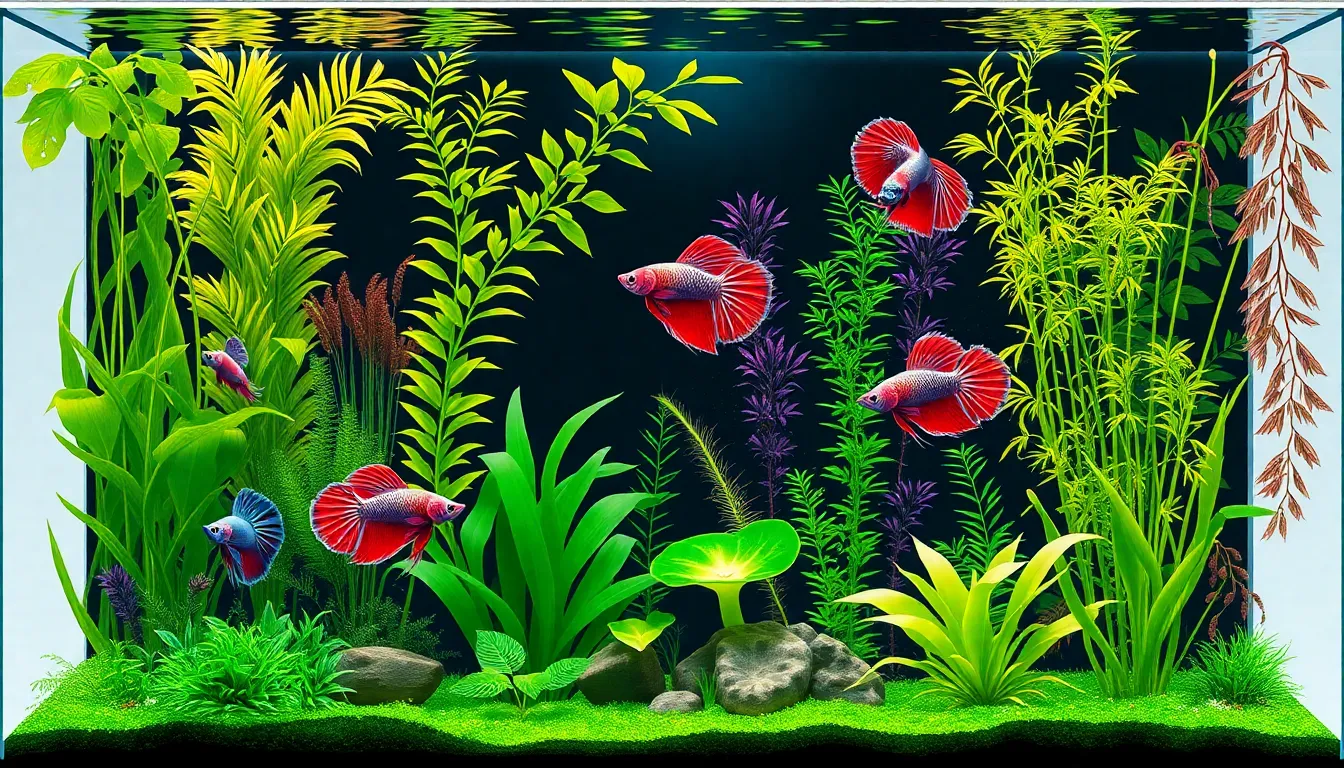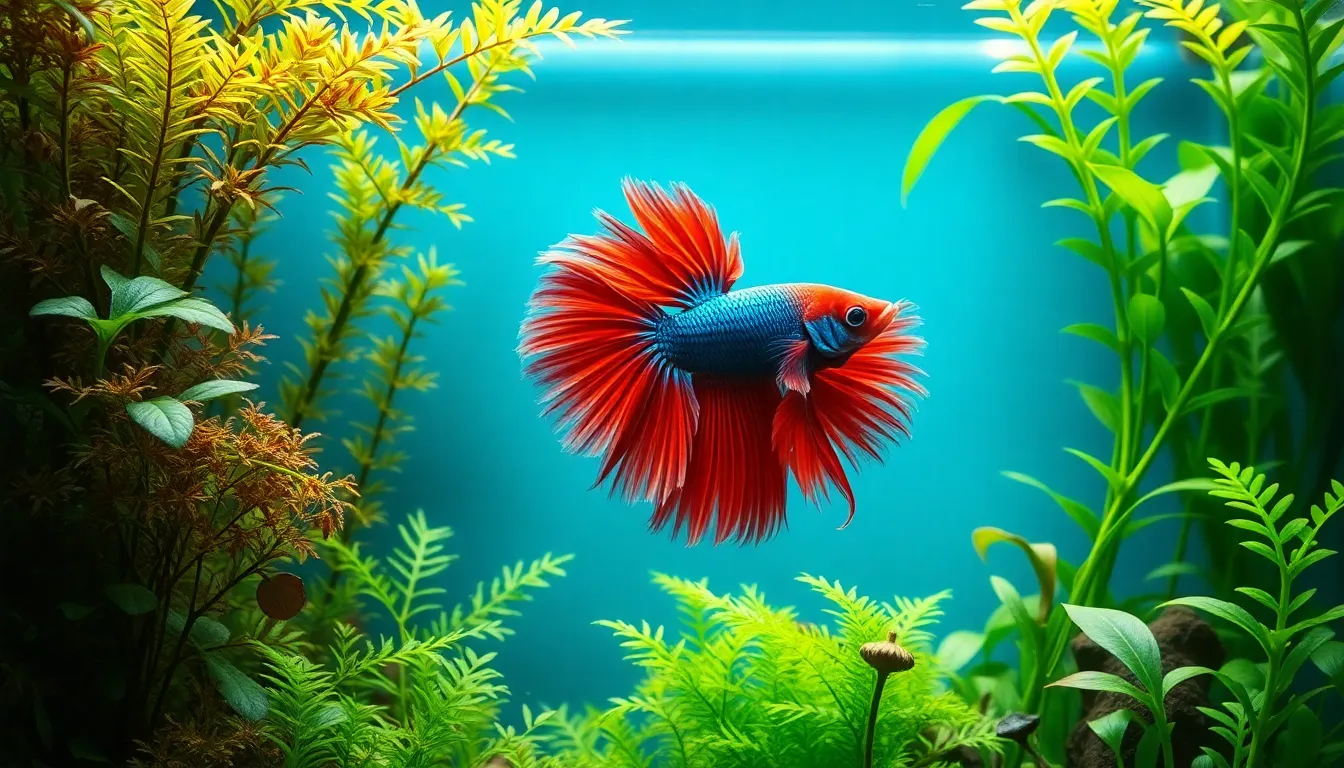Betta fish are the divas of the aquatic world, flaunting their vibrant colors and flowing fins like they just stepped off a fashion runway. But even the most fabulous fish need a little greenery to complete their underwater kingdom. Enter aquatic plants—the unsung heroes of the betta tank that not only enhance aesthetics but also provide essential benefits for these finned beauties.
Aquatic Plants For Betta Fish
Aquatic plants significantly enhance the health and environment of betta fish. They create a balanced ecosystem within the tank.
Improved Water Quality
Plants contribute to improved water quality in several ways. They absorb harmful substances like ammonia and nitrates, which can lead to poor fish health. Activated by photosynthesis, plants release oxygen into the water, enriching the habitat. Numerous species, such as Anubias and Java Fern, thrive in aquariums and help maintain a cleaner environment. Maintaining water quality supports the overall health of betta fish and promotes longer lifespans.
Natural Hiding Spots
Natural hiding spots benefit betta fish by providing security and reducing stress. Aquatic plants, such as Hornwort and Water Sprite, create sheltered areas where fish can retreat. Offering these hides dramatically decreases aggression levels in tank mates. Additionally, hiding spots encourage natural behaviors, making fish feel secure in their environment. The presence of plants enhances the aesthetic appeal of the aquarium while providing essential retreats for shy bettas.
Types Of Aquatic Plants Suitable For Betta Fish

Aquatic plants enhance betta tanks significantly. Various plant types suit these fish, each offering unique benefits.
Floating Plants
Floating plants provide excellent cover for betta fish. They naturally shade the tank, reducing direct light that can stress bettas. Plants like Amazon Frogbit and Duckweed offer a cozy environment. These plants also help filter water by absorbing excess nutrients. Providing a calm habitat, floating plants encourage bettas to exhibit natural behaviors, thus improving their overall well-being.
Submerged Plants
Submerged plants are essential for oxygenating the aquarium. Species like Anubias and Java Fern thrive underwater, creating shelters for bettas. These plants contribute to the tank’s aesthetic, offering rich greenery that enhances the visual appeal. Additionally, submerged plants help maintain a balanced ecosystem by absorbing ammonia and nitrates, fostering a healthier environment for fish. Bettas often appreciate the cover of these plants, leading to decreased anxiety levels.
Emergent Plants
Emergent plants grow partially above the water’s surface, providing unique benefits. Plants such as Bamboo and Water Wisteria create natural spots for bettas to explore. They not only promote oxygen exchange but also facilitate the absorption of toxins from the water. The structure of emergent plants offers bettas a sense of security, helping them thrive in their environment. Moreover, these plants add layers of interest to the aquarium, enriching the overall experience for both the fish and the keeper.
Care And Maintenance Of Aquatic Plants
Correct care and maintenance of aquatic plants ensure their health and benefit betta fish. Essential practices include appropriate lighting and fertilization.
Lighting Requirements
Aquatic plants require specific lighting conditions to thrive. A light duration of 10 to 12 hours per day promotes healthy growth. LED or fluorescent lights provide the best options, as they are energy efficient and promote photosynthesis. Establishing an algae-free environment becomes easier with the right intensity. Different plant species may need varying light levels; for instance, Anubias prefers low light, while Java Fern enjoys moderate light. Adjusting the distance of light fixtures from the water surface supports optimal growth, providing enough energy without harming the plants.
Fertilization Tips
Fertilization plays a critical role in maintaining vibrant aquatic plants. Liquid fertilizers offer a balanced dose of essential nutrients for thriving plant life. Incorporating root tabs enhances nutrients directly at the plant roots, which benefits heavy feeders. Regularly testing water parameters ensures the right nutrient levels, preventing deficiencies. Following recommendations on product labels aids in proper dosing. Observing plant growth and health indicates whether adjustments are necessary. Avoiding over-fertilization minimizes algae growth, maintaining a clean environment for betta fish.
Common Issues With Aquatic Plants
Aquatic plants can encounter various issues that affect their health and the aquarium’s ecosystem. Understanding these challenges can help maintain a thriving environment for betta fish.
Algae Growth
Algae growth poses a common problem for aquatic plants. Excess nutrients in the water, primarily from fish waste and uneaten food, can lead to algae blooms. These blooms compete with plants for light and nutrients, stifling plant growth and diminishing water quality. Regularly testing water parameters can identify imbalances. Implementing a schedule for water changes can also help minimize nutrient buildup. Finally, ensuring adequate lighting reduces the chances of algae overgrowth, providing plants with sufficient energy for photosynthesis.
Plant Diseases
Plant diseases can significantly impact aquatic flora. Factors such as poor water quality, inadequate lighting, and pest infestations contribute to unhealthy plants. Symptoms include yellowing leaves, stunted growth, or holes in foliage. Identifying these issues early can prevent further problems. Monitoring water conditions regularly allows for timely adjustments to pH levels and nutrient availability. Additionally, cleaning plants and removing affected leaves can reduce disease spread, promoting overall plant vitality in the aquarium. Practicing good hygiene can safeguard against future infestations, ensuring a healthy environment for betta fish.
Conclusion
Incorporating aquatic plants into a betta fish tank is essential for creating a thriving and visually appealing environment. These plants not only enhance aesthetics but also play a critical role in maintaining water quality and providing shelter. By selecting the right species and ensuring proper care, fish owners can promote the health and well-being of their bettas.
Regular maintenance and attention to light and nutrient levels will help prevent common issues like algae growth and plant diseases. A well-planned aquatic landscape can significantly reduce stress for bettas and encourage natural behaviors. Ultimately, the right aquatic plants can transform a simple tank into a vibrant and harmonious ecosystem.

